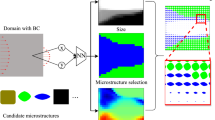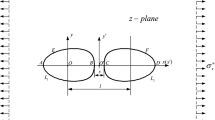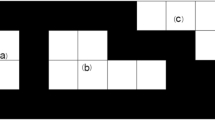Abstract
The construction of two novel integration algorithms are proposed by formulating Runge-Kutta embedded techniques based on geometric mean (GM) coupled with contra-harmonic mean and harmonic mean with error control under general cellular nonlinear network paradigm. This paper attempts to analyze the performance of hole-filling cellular nonlinear network arrays through potential behaviour of newly proposed versatile algorithm. A promising simulation result shows that more quantitative analysis has been carried out to clearly visualize the goodness and robustness of the proposed embedded algorithms for hole-filler.
Similar content being viewed by others
References
Lee, C.-C., Pineda de Gyvez, J.: Single-layer CNN simulator. IEEE Int. Symp. Circuits Syst. Proc. 6, 217–220 (1994)
Chua, L.O., Yang, L.: Cellular neural networks: theory. IEEE Trans. Circuits Syst. I, Fundam. Theory Appl. 35, 1257–1272 (1988)
Chua, L.O., Yang, L.: Cellular neural networks: applications. IEEE Trans. Circuits Syst. I, Fundam. Theory Appl. 35, 1273–1290 (1988)
Chua, L.O., Roska, T.: The CNN universal machine. Part 1. The architecture. In: Int. Workshop on Cellular Neural Networks and their Applications (CNNA), pp. 1–10 (1992)
Evans, D.J., Yaakub, A.R.: A new Runge-Kutta RK(4,4) technique. Int. J. Comput. Math. 58, 169–187 (1995)
Evans, D.J., Yaacob, N.: A fourth order Runge-Kutta method based on the Heronian mean formula. Int. J. Comput. Math. 58, 103–115 (1995)
Fehlberg, E.: Low order classical Runge-Kutta formulas with step-size control and their application to some heat transfer problems. NASA Tech. report 315 (1969), Extract published in Computing (1970), pp. 66–71
Lai, K.K., Leong, P.H.W.: Implementation of time-multiplexed CNN building block cell. In: IEEE. Proc. of Microwave, pp. 80–85 (1996)
Lai, K.K., Leong, P.H.W.: An Area Efficient Implementation of a Cellular Neural Network, pp. 51–54. IEEE Press, New York (1995)
Lotkin, M.: On the accuracy of RK methods. MYAC 5, 128–132 (1951)
Merson, R.H.: An operational method for the study of integrating processes. In: Proc. Symp. Data Processing, Weapon Research Establishment, Salisbury, S. Australia (1957)
Yaakub, A.R., Evans, D.J.: A fourth order Runge-Kutta RK(4,4) method with error control. Int. J. Comput. Math. 57, 249–256 (1995)
Yaacob, N., Sanugi, B.: 1998, A new fourth-order embedded method based on the harmonic mean, Mathematika, Jilid,hml 1-6
Nossek, J.A., Seiler, G., Roska, T., Chua, L.O.: Cellular neural networks: theory and circuit design. Int. J. Circuit Theory Appl., 20, 533–553 (1992)
Ponalagusamy, R., Senthilkumar, S.: A new RK-embedded fourth order with four stages technique to study raster CNN simulation. Int. J. Autom. Comput. 6(3), 285–294 (2009)
Ralston, R.H.: Runge-Kutta methods with minimum error bonds. Math. Comput. 16, 431–437 (1957)
Roska et al.: CNNM users guide, Version 5.3x, Budapest (1994)
Yaakub, A.R., Evans, D.J.: A fourth order Runge-Kutta RK(4,4) method with error control. Int. J. Comput. Math. 71, 383–411 (1999)
Gonzalez, R.C., Woods, R.E., Eddin, S.L.: Digital Image Processing Using MATLAB. Pearson Education, Upper Saddle River (2009)
Henrici, P.: Discrete Variable Methods in Ordinary Differential Equations. Wiley, New York (1962)
Lambert, J.D.: Computational Methods in Ordinary Differential Equations. Wiley, New York (1973)
Lambert, J.D.: Stiffness. In: Gladwell, I., Sayers, D.K. (eds.) Computation Techniques for Ordinary Differential Equations, pp. 19–46. Academic Press, London (1980)
Ponalagusamy, R., Senthilkumar, S.: Investigation on time-multiplexing cellular neural network simulation by RKAHeM(4,4) technique. Int. J. Adv. Intell. Paradig. 3, 43–66 (2011)
Anguita, M., Fernandez, F.J., Diaz, A.F., Canas, A., Pelayo, F.J.: Parameter configurations for hole extraction in cellular neural networks. Analog Integr. Circuits Signal Process. 32(2), 149–155 (2002)
Dalla Betta, G.F., Graffi, S., Kovacs, M., Masetti, G.: CMOS implementation of an analogy programmed cellular neural network. IEEE Trans. Circuits Syst., 2 Analog Digit. Signal Process. 40(3), 206–214 (1993)
Evans, D.J.: A new 4th order Runge-Kutta method for initial value problems with error control. Int. J. Comput. Math. 39, 217–227 (1991)
Sanugi, B.B.: New numerical strategies for initial value type ordinary differential equations, Ph.D thesis, Loughbrough University of Technology, UK, 1986
Evans, D.J., Yaakub, A.R.: The fifth order Runge-Kutta RK(5,5) method with error control. Int. J. Comput. Math. 79, 1179–1185 (2002)
Sanugi, B.B., Yaacob, N.B.: A new fifth order five-stage Runge-Kutta method for initial value type problems in ODEs. Int. J. Comput. Math. 59, 187–207 (1996)
Yin, C.-L., Wan, J.-L., Lin, H., Chen, W.-K.: The cloning template design of a cellular neural, network. J. Franklin Inst. 336, 903–909 (1999)
Chua, L.O., Thiran, P.: An analytic method for designing simple cellular neural networks. IEEE Trans. Circuits Syst. I, Fundam. Theory Appl. 38(11), 1332–1341 (1991)
Hänggi, M., Moschytz, G.S.: Cellular Neural Networks: Analysis, Design and Optimization. Kluwer Academic, Dordrecht (2000)
Matsumoto, T., Chua, L.O., Furukawa, T.: CNN cloning template: hole filler. IEEE Trans. Circuits Syst. 37, 635–638 (1990)
Lee, C.-C., Pineda de Gyvez, J.: Time multiplexing CNN simulator. In: IEEE International Symposium on Circuits and Systems, vol. 6, pp. 407–410 (1999)
Chua, L.O.: CNN: A paradigm for complexity (1998)
Roska, T.: CNN software library. Hungarian Academy of Sciences, Analogical and Neural Computing Laboratory (2000). Online available: http://lab.analogic.sztaki.hu/Candy/csl.html, 1.1
Murugesh, V., Badri, K.: An efficient numerical integration algorithm for cellular neural network based hole-filler template design. Int. J. Comput., Commun. Control 2, 367–374 (2007)
Murugesan, K., Elango, P.: CNN based hole filler template design using numerical integration technique. In: Lecture Notes in Computer Science, vol. 4668, pp. 490–500 (2007)
Author information
Authors and Affiliations
Corresponding author
Rights and permissions
About this article
Cite this article
Senthilkumar, S. Hole-Filler Cellular Neural Network Simulation by RKGHM(5,5). J Math Imaging Vis 43, 194–205 (2012). https://doi.org/10.1007/s10851-011-0300-4
Published:
Issue Date:
DOI: https://doi.org/10.1007/s10851-011-0300-4




